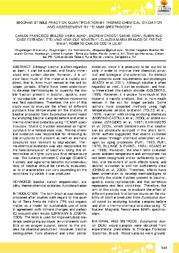Biochar stable fraction quantification by thermochemical oxidation and assessement by 13C-NMR spectrocopy.
Biochar stable fraction quantification by thermochemical oxidation and assessement by 13C-NMR spectrocopy.
Author(s): ALHO, C. F. B. V.; CROSS, A.; SOHI, S.; RODRIGUES, R. C.; NOVOTNY, E. H.; MAIA, C. M. B. de F.; LELIS, R. C. C.
Summary: Although biochar is often regarded lized into carbon dioxide. However, it is unclear how much of this material is rapidly oxidized, that is, how much remain in the soil for NQPIGTRGTKQFU'ƑQTVUJCXGDGGPWPFGTVCMGP to develop methodologies to quantify the stable fraction present in biochar, quickly, easily reproducible, and that somehow represents TGCN?GNFEQPFKVKQPU6JGTGHQTGVJGCKOQHVJKU UVWF[YCUVQGXCNWCVGVJGGƑGEVQHFKƑGTGPV R[TQN[UKU?PCNVGORGTCVWTGUQPVJGUVCDKNKV[QH biochar produced from Eucalyptus dunnii wood by analyzing biochar samples before and after a thermo-chemical oxidation using 13 C NMR spec- troscopy. Stable-C fraction increased as higher R[TQN[UKU?PCNVGORGTCVWTGYCU6JGTOQEJGOical oxidation was responsible for removing labile structures still present as well as aromatic structures less resistant to degradation. Thermo-chemical oxidation was also responsible for the functionalization of biochars, being this ef- HGEVOKNFGTCUJKIJGTR[TQN[UKU?PCNVGORGTCVWTG was. The balance between C storage (Stable-C HTCEVKQPCPFCITQPQOKEDGPG?VU HWPEVKQPCNK\Ction) of biochar should be carefully evaluated, as its characteristics can vary depending on the conditions by which it was produced.
Publication year: 2013
Types of publication: Abstract in annals or event proceedings
Unit: Embrapa Soils
Observation
Some of Embrapa's publications are published as ePub files. To read them, use or download one of the following free software options to your computer or mobile device. Android: Google Play Books; IOS: iBooks; Windows and Linux: Calibre.
Access other publications
Access the Agricultural Research Database (BDPA) to consult Embrapa's full library collection and records.
Visit Embrapa Bookstore to purchase books and other publications sold by Embrapa.

